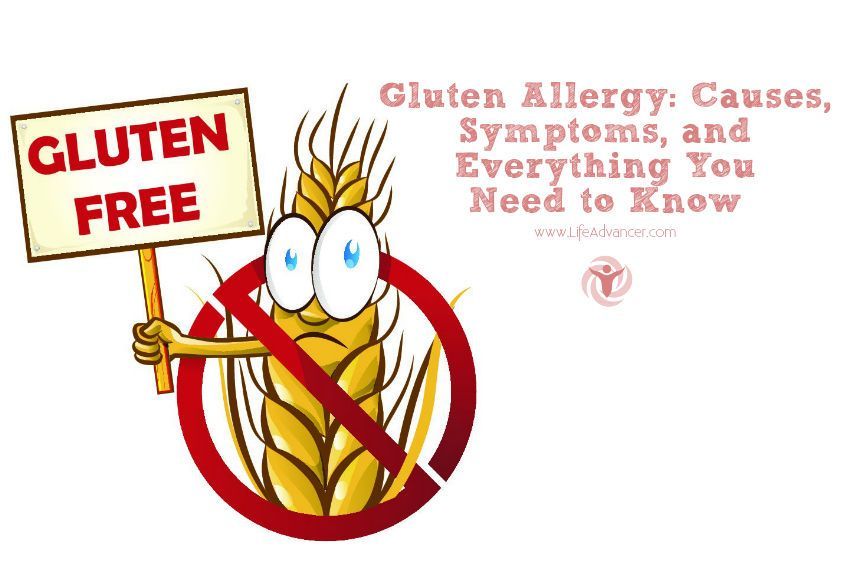
If you suffer from a gluten allergy or have celiac disease, you know what an inconvenient, and painful condition it can be. The rates of gluten allergy have risen sharply and people are looking to get a better understanding.
Gluten as a topic has not gone away and probably won’t for a while. It’s been hard to open any magazine, website, or article that hasn’t touched on the gluten allergy issue. Some people had dismissed it and many others who suffer from it know that it is all too real.
It comes back to educating yourself in the best way you can and getting up to speed with all nutrition issues. Gluten is not understood by everyone but it’s important to boost your knowledge on the subject to see how it may pertain to you.
This article will share everything you need to know about gluten allergy including the causes and symptoms.
What Is A Gluten Allergy?
This is probably the best place to start as the concept of being allergic to a food may confuse people. Most people know of the deadly food allergies such as peanut or shellfish allergies but how does gluten stack up against these?
A gluten allergy (or gluten intolerance) is one of the top 8 food allergens out there and it’s an immune response to the gluten protein that is found in wheat. The most extreme example of this is a celiac disease where it’s a full-on autoimmune disorder where your immune system abnormally reacts to gluten.
This leads to the breakdown of the villi and microvilli which are in your small intestine and which absorb nutrients.
With celiac, you will have trouble getting proper nutrition and the condition itself leads to other issues such as:
- Cramping
- Bloating
- Constipation
- Diarrhea
- Stomach pain
- Nausea and vomiting
They consider a gluten allergy Non-Coeliac Gluten Sensitivity or NCGS. It’s different from celiac but might present similar symptoms in people who are not diagnosed as celiac or even as having a wheat allergy. With gluten sensitivity people report discomfort after consuming gluten and experience some of the following issues:
- Mental fatigue or “brain fog“
- Fatigue
- Gas, bloating, and abdominal pain
- headache
- Bad skin
- Painful joints
What Is Gluten?
It’s worth looking at this as some people still feel unfamiliar with what gluten is. Gluten is a sticky protein found in the seeds of grasses. We call these seeds grains and the name gluten comes from the Latin word which literally means “glue“.
This is a good way of looking at gluten as it can stick to your intestines causing this breakdown of the villi and microvilli. The villi and microvilli are finger-like projections that come off the inside of the small intestine and you can picture them like shags on a shag carpet.
Over time, the gluten can break them down until your left with a subfloor. This is where the incredible pain can come from for people experiencing celiac disease. This also can lead to leaky gut syndrome and the gluten can get through the gut and into the body.
When we talk about the immune system, you may think of it as a bodily organ but it’s a collection of cells and most of them exist on the other side of the gut. When particles like gluten get through this gut barrier your immune system attacks them because they are like an army defense and the gluten is a foreign invader.
The problem is your immune system recognizes the same characteristics of the gluten in other parts of your body and it turns on itself. One example is your joint and connective tissue which your immune system can think is gluten and attack.
These symptoms can mimic rheumatoid arthritis and leave you in a lot of pain.
How Did Gluten Get Like This?
Humans have been consuming gluten for thousands of years so why is something like a gluten allergy becoming more prevalent? It is because of the evolution and hybridization of gluten over the centuries. Gluten in its primitive form was called einkorn, and it was left over from the ice age when the glaciers retreated scraping back the soil allowing primitive plants to sprout up.
Einkorn was a simple iteration of gluten-containing just 14 chromosomes. The wheat of biblical times was known as emmer wheat and it had evolved more from the einkorn but was still more simple than the wheat of today having 28 chromosomes (Plants can double their chromosomes).
This version of gluten would last until the middle ages. In the 1960s world hunger became front and center and scientists worked to grow more food to tackle the problem. An American biologist named Dr. Norman Borlaugdeveloped a high-yield version of wheat called the “semi-dwarf variant“.
They did this through a lot of science and development and it allowed for wheat yields to be increased tenfold. This was all done out of noble intentions but no one really looked at what all this genetic manipulation, and mutation, was doing to the wheat.
Famers who used to grow 8 bushels an acre were seeing other farmers now growing 80 per acre. This variety of wheat would obviously become much more prominent and profitable. If you see a modern wheat field today the “amber waves of grain” are gone and most plants are only 2-2.5 feet high with a thicker stalk and a denser amount of grains.
The New Wheat
So all this selective hybridization and induced mutations gave us a plant with 42 chromosomes including the D-genome which greatly increased the gluten concentration. This form of gluten is much stickier and has more of a “viscoelasticity” which lends it well to make things like pizza dough.
Gluten and wheat are also cheap and you find it in more and more products. Anything that comes out of a box or package you can be sure contains wheat or has been in contact with wheat. The concentrations of gluten are now so strong this might be what’s responsible for the gluten allergy popping up in so many people today.
Since 2003, 1 in 133 people will develop celiac disease, and even more, may develop a gluten allergy. Dr. Alessio Fasano from Harvard is one of the leading authorities on gluten in the world and believes that humans have not evolved enough yet to digest and absorb gluten.
What Else Should You Know About Gluten Allergy?

If you’ve experienced symptoms listed here after consuming gluten there’s the chance you may have a gluten allergy. And if it’s been getting worse, you must see a doctor to get a proper diagnosis. Maybe you’ve been getting less intense symptoms, in this case, you can do a food elimination test to see if a gluten allergy may affect you.
This involves gutting out gluten for at least a week, but ideally two. You then would slowly add gluten back in and pay attention to any responses after you eat it. If the cramping, headaches, brain fog, and digestive issues come back it can be a good indicator it may cause you a problem.
You can also do this food elimination test with eggs and dairy in case those are causing you issues too. The main thing is you don’t need gluten at all in your diet. It’s great for a treat but it’s not an essential nutrient or a required mineral that your body requires.
You may do yourself a favor by avoiding it as much as possible because you’ll also be avoiding a high glycemic starchy carb and one that comes with a lot of other inferior ingredients associated with it.
If you’re still wanting to consume it at least find the best quality, you can get. Look for bread that comes from real bakeries that use locally grown rye or wheat that’s organic. It will have higher fiber content and is milled and baked in more traditional methods.
At the least, avoid any white bread or pasta as not only will that have a high gluten content it’s overly starchy and quick acting in the body.
Fortunately, if you have a gluten-related health condition, removing gluten from your diet will likely improve your symptoms.
This article provides 12 simple tips to help you eliminate gluten from your diet.
1. Choose Gluten-Free Grains
Wheat, barley, and rye are popular gluten-containing grains. However, there are plenty of gluten-free grain alternatives.
Examples of gluten-free grains include (4):
quinoa
brown rice
millet
amaranth
buckwheat
oats
Despite its name, buckwheat is a grain-like seed that’s unrelated to wheat and naturally gluten-free. Buckwheat can be enjoyed as a cereal or used in recipes for gluten-free baked goods (5).
Oats are naturally gluten-free but may contain traces of gluten from exposure during processing. If you have celiac disease or gluten sensitivity, choose oats with a certified gluten-free label (6).
Summary
To avoid gluten exposure from common grains, choose gluten-free grain alternatives like quinoa, brown rice, or buckwheat.
2. Look for a Gluten-Free Certification Label
The Food and Drug Administration (FDA) regulates gluten-free claims on food packaging.
A product claiming to be gluten-free must comply with the FDA gluten-free definition by containing less than 20 parts per million (ppm) of gluten. The European Union (EU) has similar legislation for food products labeled as gluten-free (7, 8).
What’s more, many third-party organizations have established gluten-free certifications for food manufacturers. These are additional certifications, and the food product must still comply with governmental regulations.
For example, the Gluten Intolerance Group established the Certified Gluten-Free label, which requires products to contain 10 ppm or less of gluten. This organization requires ongoing testing and annual inspections to ensure compliance (9).
Summary
The FDA and EU regulate products that claim to be gluten-free. Additionally, some third-party organizations have established gluten-free certifications.
3. Eat More Produce
All fresh fruits and vegetables are naturally gluten-free.
Gluten-free diets may lack micronutrients like folate and magnesium unless gluten-containing products are replaced with other nutrient-dense foods. Including more fresh produce in your diet can help you acquire these nutrients and eliminate gluten (10).
Here are a few ways to add more fresh produce to your diet:
ask for a lettuce wrap in place of bread
use spiralized veggie noodles in place of regular pasta
opt for a salad instead of a sandwich
use roasted potatoes or butternut squash for a gluten-free side dish
choose a side of fresh fruit or roasted vegetables
add a piece of fruit to your breakfast or eat it as a snack
use sweet potato slices in place of bread
Some processed fruits and vegetables, such as frozen or canned products, may contain gluten as a food additive or thickening agent. It’s best to check the label for gluten or wheat if choosing canned, frozen, or dried fruits and vegetables.
Summary
Eating more produce is a great way to eliminate gluten and optimize your intake of nutrients that may otherwise be lacking in a gluten-free diet.
4. Clean Out Your Pantry
Evaluate your current pantry items and clean out any products that may contain gluten.
The best way to identify if a product contains gluten is to read the ingredient list. Throw out or donate items that contain grains like wheat, barley and rye. Check for lesser-known gluten-containing ingredients like malt vinegar, brewer’s yeast and seitan.
Eliminating gluten from your diet can be difficult if other household members don’t require the same dietary restrictions.
In this case, consider dedicating a section of your pantry to gluten-free items. This also helps avoid potential cross-contamination and accidental gluten exposure.
You can also avoid accidental exposure by using a separate toaster and washing cutting boards and utensils before preparing your meals.
Summary
Clean out any items in your pantry that contain wheat, barley or rye. If other household members don’t require the same dietary restrictions as you do, you can dedicate a section of your pantry to gluten-free items to avoid accidental gluten exposure.
5. Avoid Gluten-Containing Beverages
Gluten may be present in certain beverages, especially those containing alcohol.
Beer is a common source of gluten because it’s produced by fermenting gluten-containing grains like wheat or barley. However, there are some gluten-free beers on the market made from ingredients like sorghum or rice (11).
If you want to drink alcohol on a gluten-free diet, opt for distilled liquors like vodka or gin. Typically, wine is also free from gluten. That said, wine coolers may contain malt barley, a gluten-containing grain.
Most non-alcoholic beverages like coffee, tea and sparkling water products are gluten-free. Nonetheless, some drinks like pre-made smoothies, coffee drinks or milkshakes may contain gluten, so it’s best to check the label.
Summary
Avoid gluten-containing beverages like beer, wine coolers and some pre-made smoothies. Instead, choose gluten-free beverages like water, coffee, and tea.
6. Bring Your Own Food
If attending a social event, consider bringing your own gluten-free dish.
Accidental gluten exposure is common at social events. Even if a dish is inherently gluten-free, cross-contamination during cooking may pose a risk to people who require strict gluten elimination.
Offer to bring a dish to share with others. Having at least one gluten-free dish to enjoy can reduce social stress and limit potentially harmful gluten exposure.
Summary
Social events may pose a risk for gluten exposure. Bringing a gluten-free dish from home is a great way to ensure a safe food environment without too much fuss.
7. Eat More Nuts and Seeds
Gluten-free diets are more likely to be deficient in nutrients like zinc, calcium and fiber (10).
Nuts and seeds are naturally gluten-free and are great sources of these nutrients (12, 13).
Nuts and seeds to add to your diet include:
almonds
cashews
pecans
walnuts
pistachios
macadamia nuts
pumpkin seeds
flax seeds
chia seeds
sunflower seeds
You can add nuts or seeds to gluten-free oats, finely grind nuts to use in place of wheat flour, sprinkle seeds over your salad or blend nuts into nut butter to enjoy with apple slices or celery sticks.
Summary
Nuts and seeds are naturally gluten-free and are great sources of zinc, calcium and fiber, all of which are nutrients that gluten-free diets may lack.
8. Know the Different Names for Wheat
There are many different wheat varieties, which can make it difficult to read food labels. Look for these wheat varieties when assessing a label for hidden sources of gluten (4):
durum
einkorn
khorasan (Kamut)
spelt or farro
triticale
Many types of wheat flour also have different names like semolina, farina or graham flour. All of these flours contain gluten and must be avoided if you follow a gluten-free diet.
Moreover, common food additives may contain hidden sources of wheat like maltodextrin, caramel color and modified food starch.
Evaluating the allergens statement on a food label is the easiest way to identify whether a product contains wheat and gluten. This is because the FDA requires foods to clearly state if they contain any of the top eight allergens, such as wheat, on the food label (14).
Summary
There are many different names for wheat like durum, kamut and spelt. Evaluate the ingredient list and allergens statement on a food label to identify and eliminate sources of wheat.
9. Limit Processed Food
Food manufacturers can add gluten to processed foods to improve texture, mouthfeel and shelf life. For example, lunch meat, sausage, baked goods, french fries and seasoned rice mixes may all contain hidden sources of gluten.
What’s more, processed gluten-free products are often higher in fat, sugar and sodium than regular products. Thus, while these products are gluten-free, they may not be a favorable replacement for whole foods (15).
Whole foods, such as fruits, vegetables, eggs, nuts and seeds, are naturally gluten-free. Focus on eating more of these whole foods while limiting your intake of processed food.
Summary
Food manufacturers may add gluten to food products to improve texture and shelf life. Limit processed foods and eat naturally gluten-free whole foods like fruits, vegetables, nuts, seeds and lean proteins.
10. Cook More Meals at Home
Restaurants are increasingly offering gluten-free meal options. However, these meals typically come with an added cost, as well as the risk of cross-contamination.
Cooking more meals at home can help you eliminate gluten from your diet, all while benefiting your overall health.
In fact, people who eat home-cooked meals at least 5 times per week eat significantly more fruits and vegetables and are 28% less likely to be overweight than those who eat home-cooked meals less than 3 times per week (16).
Create a weekly meal plan to stay accountable. Stock your kitchen with gluten-free staples like fresh produce, nuts, seeds, legumes, protein sources like eggs and fish and various gluten-free grains.
Summary
Dining out on a gluten-free diet can be expensive and may increase your risk of cross-contamination. Eating more home-cooked meals is a safe option that also benefits your overall health.
11. Avoid Gluten-Containing Condiments
Condiments and sauces often contain hidden sources of gluten. Food manufacturers can add gluten to condiments to act as a stabilizer, thickener or emulsifier.
Condiments that may contain gluten include:
soy sauce
salad dressing
malt vinegar
marinades
barbecue sauce
pasta sauce
Worcestershire sauce
teriyaki sauce
Reviewing the allergens label on these condiments is helpful. It’s important to remember that even if a condiment is wheat-free, it may contain gluten from barley or rye. For example, malt vinegar is not gluten-free because malt is derived from barley (4).
Summary
Many condiments contain added sources of gluten. It’s best to read labels thoroughly and choose only condiments labeled as certified gluten-free.
12. Join a Gluten-Free Community
Following a gluten-free diet may feel isolating. In fact, people with celiac disease may be more likely to suffer from feelings of loneliness, depression and social phobia (17, 18, 19, 20).
Joining a gluten-free community is a great way to find resources, community recommendations and support from other people with similar dietary restrictions.
The National Celiac Association has various chapters around the U.S. that offer conferences, small meetings and support for individuals living with celiac disease.
Summary
Following a gluten-free diet may feel isolating without the right support. Join a gluten-free community to help navigate local restaurants, share recipes and find support.
The Bottom Line
Most people can eat gluten without any side effects.
However, certain individuals, including those with celiac disease or non-celiac gluten sensitivity, need to avoid it, as it can cause harmful symptoms.
Along with carefully reading nutrition labels, you can also eliminate gluten from your diet by eating more whole foods, increasing your intake of gluten-free grains and cooking more meals at home.
Disclaimer: We at Prepare for Change (PFC) bring you information that is not offered by the mainstream news, and therefore may seem controversial. The opinions, views, statements, and/or information we present are not necessarily promoted, endorsed, espoused, or agreed to by Prepare for Change, its leadership Council, members, those who work with PFC, or those who read its content. However, they are hopefully provocative. Please use discernment! Use logical thinking, your own intuition and your own connection with Source, Spirit and Natural Laws to help you determine what is true and what is not. By sharing information and seeding dialogue, it is our goal to raise consciousness and awareness of higher truths to free us from enslavement of the matrix in this material realm.
 EN
EN FR
FR


























There are many cross contaminated items listed here as gluten free. For example, coffee and nuts. Look up the list. I’ve had Celiac disease for 8 years and there are a ton of hiding places. Medicine has it too. I learned the hard way.
Great Article & information, Thank you.